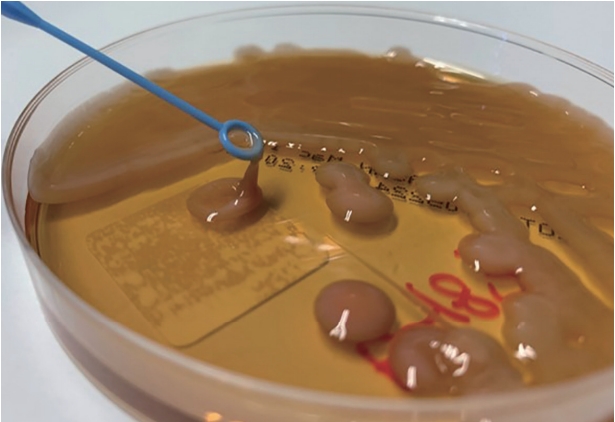Various initial presentations of community onsethypervirulent K2 serotype Klebsiella pneumoniae in healthy adult
Article information
A previously healthy 43-year-old male patient was admitted to our hospital with a 3-day history of pain in the chest and the left scapular area. On admission, the patient was afebrile and had proteinuria. The serum creatinine level was 9.08 mg/dL (normal range, 0.9 to 1.3), and the C-reactive protein level was 27.86 mg/dL (normal range, 0.0 to 0.3). Chest computed tomography (CT) scan revealed multiple mixed ground-glass attenuation nodules of various sizes and masses in both the lungs (Fig. 1A). Abdominal CT scan revealed an 1.7 cm sized enhancing lesion in the S5 region of the liver. Our initial diagnosis was hematogenous pulmonary and liver metastasis or vasculitis-associated glomerulonephritis. However, BacT/Alert blood culture after 5 days revealed the presence of Klebsiella pneumoniae of a hypermucoviscous phenotype, defined by a positive “string” test (Fig. 2). We confirmed a K2 serotype using 16S rRNA gene analysis. The antibiotic regimen was changed to intravenous amikacin and ciprofloxacin. After 1 week, the repeat chest CT scan revealed a marked increase in the extent of multiple necrotic cavitary masses and nodules in both the lungs along with liver abscesses (Fig. 1B). However, ophthalmological examination, brain magnetic resonance imaging, and transthoracic echocardiography, showed no abnormal findings. After 6 weeks, the chest CT scan revealed markedly reduced lesions in both the lungs (Fig. 1C). The antibiotic regimen was de-escalated to ciprofloxacin for 2 months, following which a complete recovery was achieved. Informed consent was obtained from the patient.

(A) Chest computed tomography scan revealing multiple mixed ground-glass attenuation nodules and masses of various sizes in both the lungs. (B) A markedly increased extent of multiple necrotic cavitary masses and nodules in both the lungs after 1 week was noted. (C) A markedly reduced extent of multiple necrotic cavitary masses, nodules, consolidations, and surrounding mixed ground-glass attenuations in both the lungs after 6 weeks was noted.

String test confirming the hypermucoviscosity of Klebsiella pneumoniae isolates recovered from the blood culture. A positive result was defined as the formation of a viscous rope of length > 5mm when a bacterial colony was touched with a loop on the agar plate.
A new hypervirulent variant of K. pneumoniae (hvKP) has emerged in Asia. The defining clinical features are the ability to cause serious life-threatening community-acquired infections, including liver abscess, pneumonia, meningitis, and endophthalmitis, and the ability to spread like metastasis in healthy young hosts. Besides, early diagnosis may be delayed in many cases. Herein, we report a case of hvKP infection initially misdiagnosed as malignant metastasis or vasculitis in a healthy adult.
Notes
No potential conflict of interest relevant to this article was reported.
